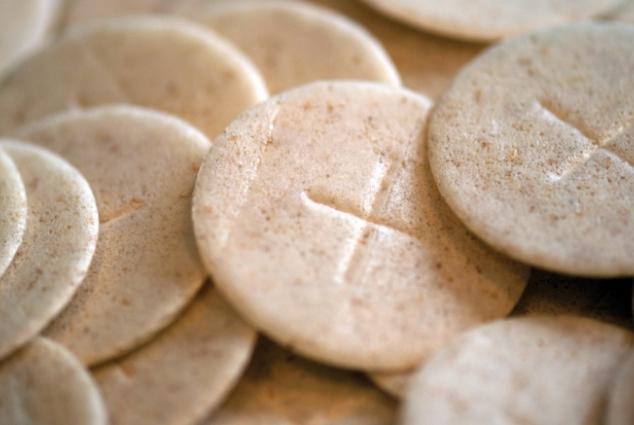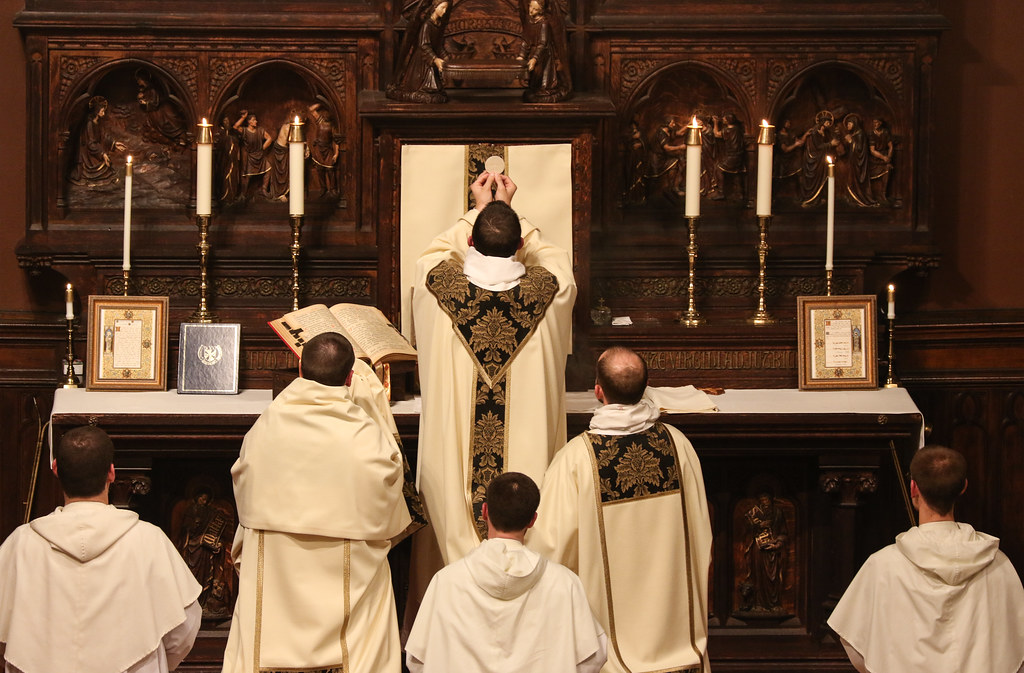
Contemporary hosts made for Holy Communion are often whole wheat and do not appear as glistening white as wafers produced with white flour.
Wafers have been used for Holy Communion by Western Christians since the late 1200s. Before that, unleavened bread–made without yeast–was used. (Western Christians adopted the use of bread without yeast in imitation of the matzah–unleavened bread–used at Passover and the Last Supper in the Gospels. The matzah was not like the crackers now sold in grocery stores; matzah and the unleavened bread used by Western Christians was more like tortilla or gyro bread.) Eastern Christians have always used bread made with yeast.
I remember in the 1970s how people joked, “It takes more faith to believe that a wafer is bread than it does to believe that it becomes the Body of Christ!” This was because the wafers do not look like anything most people think of when you ask them what bread looks like. It turns out this is because wafers are NOT technically bread at all! Both are baked goods made with flour but they are not the same just as cake and crackers are also baked goods made from flour but are not bread. Bread, by definition, is made from dough and must be kneaded and formed by hand; wafer is made from batter and is never touched until after it is baked. The first reference to Western Christians using wafers instead of bread are from the late 1200s and many people objected precisely that wafers were “not real bread.”
People also objected that the wafers were not made by monks as priests as the unleavened bread used at Mass had been. People did not think that layfolk–even nuns–should be baking the bread used for Holy Communion. (It did become common later for nuns to make wafers for churches to buy and this was a way for nuns to support themselves. Since the 1960s, making wafers for Holy Communion has become a big business that you can read about here.)
It is unclear how rapidly wafer-use spread among Western Christians but they became used uniformly across Europe by the late 1600s. Why did wafers become so popular? One reason might be that wafers did not spoil as quickly as real bread, even if it was made without yeast; this made it easier to keep the Blessed Sacrament reserved. Also, some people thought the bread or wafer used for Communion should be glistening white and it is easier to control the color of wafers than bread. Some people thought that the wafers never being touched until after they were baked was emblematic of Christ’s birth from the Virgin Mary; these people favored the use of wafers rather than bread that was touched as it was kneaded and formed.
It became standard to make a large wafer for the priest to elevate for people to reverence at the Elevation and just before Communion; the wafers that would be consumed by the layfolk were much smaller discs that were coin-sized. Preachers suggested that the coin-size wafers should remind people that God was like a vineyard owner who could hire people all day long and would pay all the workers the same coin at the end of the day (Matthew 20:1-16).
Want to know more? There are three books about the different kinds of bread used for Holy Communion:
1. Fractio Panis by Barry Craig (Germany, 2011).
2. Bread and the Liturgy: The Symbolism of Early Christian and Byzantine Bread Stamps by George Galavaris (Wisconsin, 1970).
3. The Bread of the Eucharist: Early Christian Eucharist and the Azyme Controversy, by Edward Martin (Rome, 1970).

The elevation of the Host in a contemporary celebration of the Solemn Mass by Dominican religious.
